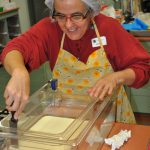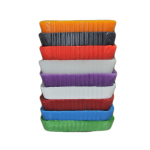Checking your thermometer is something that you should consider doing every several batches of cheese.
I receive regular emails from people that have been using their thermometers for fairly long periods of time but they are not sure if they are working correctly. Checking your thermometer is something that you should consider doing every several batches of cheese. It is very simple and quick to do and can give you good peace of mind.
How do thermometers become incorrect?
Regardless of how much you spend on a thermometer, $10 or $1000, they are all capable of providing an inaccurate reading. Inaccurate readings can be caused because it was dropped, you changed a battery or it’s just one of those electrical or mechanical things that happens from time to time. If you are using a non-water resistant or non-water proof thermometer to make cheese then the thermometers electrics may be starting to deteriorate due to water damage of the internal components.
What is a satisfactory level of accuracy for a thermometer?
For most people making cheese at home, you should be happy with your thermometer if it is within +/– 1°Cor even 2°C of a true and correct reading. However if your thermometer is out by any more than this it may affect the quality and consistency of the cheese you are making.
How do I check the level of accuracy?
There are two standard methods that you can use at home to check your thermometer. The Ice Bath or Freezing Point method and the Hot Water or Boiling Point method. You can check your thermometer by using either of these or both of these methods. If you are making yoghurt or ricotta where you are heating the milk to i.e. 90°C then the hot water method is best for you to use. If you are using cheesemaking temperatures around 30°C then the ice bath method is best to use. If you are using both high and low cheesemaking temperatures then use both methods. It does not take long and it’s a good idea to check your thermometer against both methods.
The principle of these two methods is that a pure ice and water mixture will hold its temperature temporarily at 0°C and that pure water will boil at 100°C. If your thermometer is placed in either of these mixtures then ideally it should read the same temperature as the water bath. A description of the 2 methods follows:
Ice Bath method
Materials needed: 1 litre clean and dry container (glass or plastic), 300 grams of crushed ice (not ice cubes), 200 ml of the purest water available (filtered water is best but tap water is ok providing it is not overly hard with minerals), thermometer/s to be checked
Immerse the thermometer probe by more than half way in the ice and water slurry. The mixture should be a slurry and not have large chunks of ice. Hold the thermometer in the ice water bath and move it around in a stirring action without touching the sides of the water bath. Do this until the thermometer reading stops moving. The reading on your thermometer will show how accurate your thermometer is (it should read 0°C).
Boiling water method
Materials needed: Approximately 1 litre of the purest water available (filtered water is best but tap water is ok providing it is not overly hard with minerals), a 1.5 to 2 litre saucepan, thermometer/s to be checked.
Add the water to the saucepan and place on the stove top until water boils (when there are bubbles rapidly rising to the surface not just simmering). When boiling commences turn the stove top down to its lowest setting but be careful to make sure that the water is still boiling. Immerse the thermometer probe by more than half way in the boiling water. Move the thermometer around in a stirring action without touching the sides of the saucepan. Do this until the thermometer reading stops moving. The reading will show how accurate your thermometer is (it should read 100°C).
How to adjust the thermometer if the reading is inaccurate?
Not all thermometers can be adjusted. Both of the thermometers that I provide on the Cheesemaking Shop are waterproof and have an ability to be calibrated by the freezing point or boiling water method. Manufacturer’s instructions are provided with each thermometer. When you test your thermometer and it is out by i.e. 2°C then you can adjust the thermometer by holding down the calibration button on the thermometer. If your thermometer is not adjustable then then next time you make cheese just add or subtract that difference each time you take a thermometer reading when you make the cheese. If the thermometer is out by more than 2°C you can still do the addition or subtraction, but it is probably time to look at replacing your thermometer



